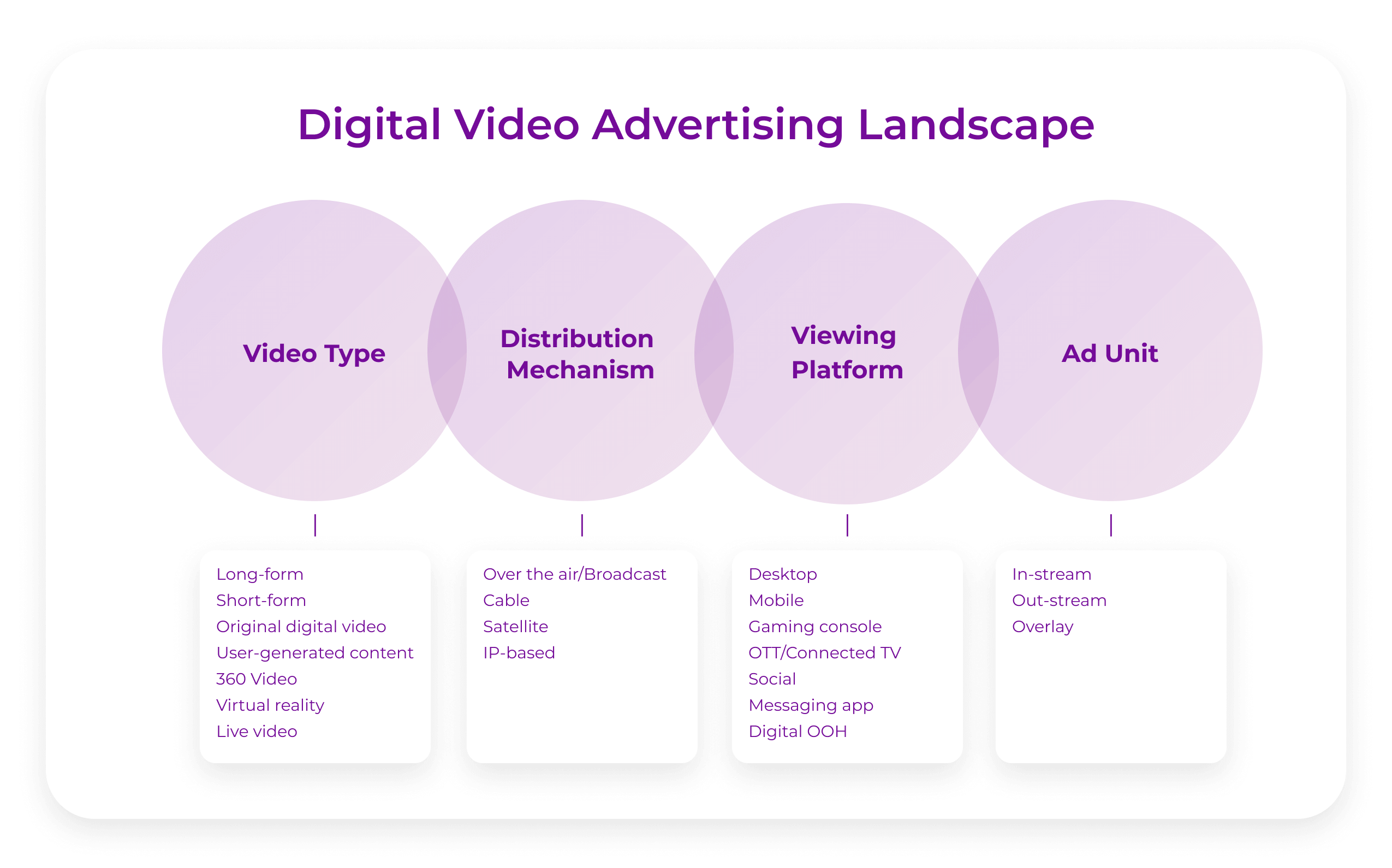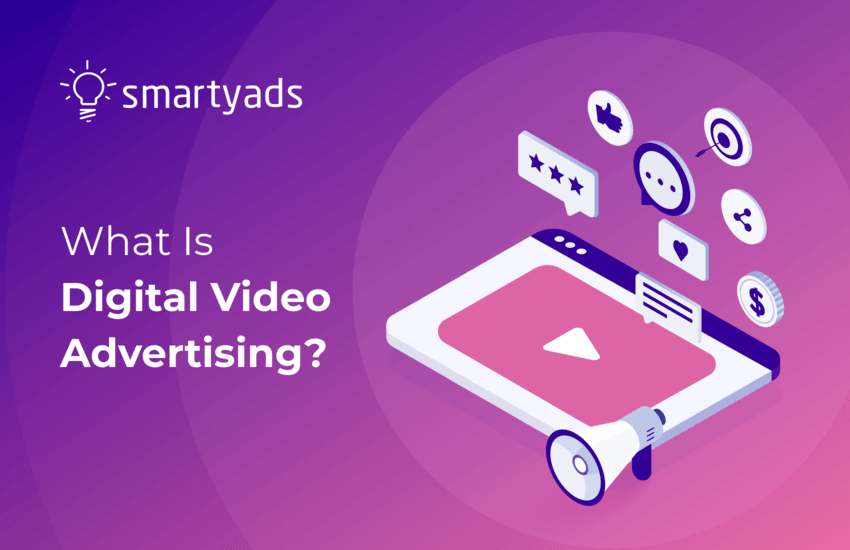The ad tech industry is continually changing its forms and formats from plain text to augmented reality campaigns. While digital video ads are not new, their significance has grown significantly throughout the last couple of years. This isn't surprising - desktop and mobile devices are becoming more accessible and sophisticated, so people are spending more time consuming digital media.
Among these, video formats are currently unique, as they are highly immersive and accessible at the same time. With tons of video content and advanced technologies, digital video advertising is becoming one of the fastest-growing display advertising formats. In this post, we are going to make a profound digital video advertising overview.
What is digital video advertising
Digital video advertising is a part of the digital advertising that displays video ads - either standalone or within online video content. This includes lots of formats designed for various environments, such as banner video, connected TV, or other OTT services. Digital video ads are usually traded via programmatic platforms; for this, advertisers utilize advanced targeting solutions.
One can choose among many display video ad formats such as linear or nonlinear, in-stream, or out-stream. Video marketing is useful for all sorts of business goals starting from building brand awareness to increasing sales and revenues.
Evolution of digital video advertising
To understand the current state and potential of digital video advertising, one should first understand what the origins of this unique advertising format are.
The first video ad was displayed on a billboard in New York during a baseball match in 1941. Same year and place, the first television commercial was broadcasted and seen by around 4000 people. With the introduction of TV, videos have quickly become the most effective advertising types for quite a long time. Right now, television is losing its popularity, and the internet gradually conquers the world.
While most of us are used to video advertising in the format of TV commercials, it wasn't so common for marketers to rely on video up until the mid-2000s. In the world of digital advertising, the video started to get more attention only in 2005 when YouTube popped into the scene. At the same time, technological advancements boosted video consumption. In 2006 Google acquired YouTube for $1.65 billion, which further increased the platform's popularity even also.
The current landscape includes tons of digital video advertising sites, social media, mobile app ads, games, connected TV, - consumers embrace videos and high-quality content, so the list is only getting longer. Cisco predicts that by 2023 the proportion of related TV sets will reach 66% so that we will see a massive increase in demand for quality video. Furthermore, 5G adoption is accelerating, and by 2023 11% of devices are expected to obtain 5G capability, which will advance digital video advertising even further. Let us now turn our attention to the potential benefits offered by such transformation.
Why digital video advertising is important
What are the benefits of digital video ads, and why should marketers turn their attention to it?
A useful tool for building a connection. While display ads are doing an excellent job informing users about a particular brand or product, they are not nearly as effective as videos in building relationships with users. The combination of visuals, sounds, and motion creates a unique opportunity to convey much deeper feelings and detailed descriptions, compared to other digital ad formats. This makes your message much more memorable and allows you to build an emotional connection between your brand and your customers.
An opportunity to get attention and engagement. With the growing amount of digital media and shrinking attention spans, getting user attention is not such an easy task as it was before. Luckily, high-quality video content is still doing a great job with this, mainly if it includes storytelling elements or a strong emotional message. A unique video content grabs user attention from the first seconds and allows brands to educate and entertain users while boosting their interest and engagement.
Universal solution for any business. Another unique feature of digital video ads is that they work equally well for most people regardless of age, gender, country of origin, or other factors. As a result, we can see that any brand from any industry can use videos for their marketing campaigns successfully. It doesn't matter whether the company is B2C or B2B, what are its business goals, and so on - good video content will do its job in any case.
One of the fastest-growing formats. According to IAB, connected TV ad spends expected to grow by 8% in 2020 despite the COVID impact on the industry. This is one of the most substantial results compared to other digital advertising formats. Taking into consideration technological breakthroughs and the further growth of video consumption, one can see that digital video advertising quickly becomes a must for every business.
How digital video ads work:
Now it's time to take a look at how digital video advertising works powered by programmatic algorithms. There are some possible variations to the process, but the usual mechanism of displaying a video ad looks like this:
Step 1. A user opens a website page. The ad tags within a video player send request an ad server to deliver the ad.
Step 2. Depending on the type of deal, an ad server either retrieves an ad directly (non-RTB) or waits for an RTB auction to run the sale and decide which targeted ad should be served to this user.
Step 3. An ad server counts an impression and sends the link to the video ad, which is usually hosted within a content delivery network.
Step 4. A video player gets the video file from the content delivery network and displays it to the user.
As we can see, the process is quite simple, and precisely the demand-side platform makes video ad serving a matter of milliseconds. The creation and calibration of digital ads are similar to other formats, so even a novice advertiser can easily handle it on programmatic platforms.
The digital video advertising landscape
After exploring what digital video advertising is and how it works, we can move on to the types of video ads and their place within the programmatic ecosystem. The digital video ads landscape is broad and includes lots of different frameworks. To avoid confusion, let us turn to the well-structured classification suggested by the IAB:
- By content. Video ads can be short or long, which is defined by their duration - clips that last longer than 15 seconds are considered long. They can also be characterized by format (horizontal or vertical) and authors (professional or user-generated). Apart from this, video types can include the newest compositions, such as 360 videos, VR and AR.
- By distribution mechanism. As suggested by the name, this classification considers various distribution methods, such as broadcast, cable, satellite, IP-based, etc.
- By platforms. Different platforms and devices require different specifications of content and format the video ads, so this categorization is especially essential when you create an omnichannel marketing strategy. These can be desktop or mobile devices, gaming consoles, social and messaging apps, OTT and connected TV, and digital OOH.

Categorization by ad unit.
This one might seem tricky at first glance, but if one dives in a bit deeper, it becomes clear that such a structure is well-defined and easy to grasp.
First of all, there are linear and nonlinear video ads. Linear ads are placed right between video content, just like it works on a TV. It can be a part of a pre-roll ad campaign, which means that an ad will be displayed before video content. There can also be a mid- or post-roll ad, which is placed during or after streaming the video content.
Nonlinear ads are served simultaneously with the video content - ideally, these shouldn't disrupt the user experience and might work more as an invitation for further engagement. Both types can be served with "companion ads" that are shown outside the video player.
Next, there are in-stream and out-stream digital video ads. Much like linear ads, in-stream adsare displayed within, before, or after streaming the video. Out-stream adsusually take place within pages focused on other types of content, such as news, blog posts.
Finally, out-stream ads are further broken down into subcategories and include the following formats:
- In-banner video. These are short clips displayed within a banner, as opposed to static creatives.
- In-article video. These ads are displayed within editorial content and are played between paragraphs while the user scrolls down the page.
- Native video.Depending on the context and environment, these videos can appear as recommendations, in-feed units, or promoted listing. Native ad formats mimic the environment and are usually more engaging.
- In-feed videos appear within the social, product, or content feeds and often include a headline and a description.
- Interstitial video. Covering 100% of the screen, these ads are hard to miss. They usually appear when the user is switching between content pages or while using a mobile app.
- Rewarded video.Similarly to interstitials, paid video ads are taking all the space on the screen. They are mostly displayed on mobile and are followed by a reward within a mobile app. This way, the user can get additional bonuses or services within an app in exchange for watching an ad.
Conclusions
Digital video advertising is a unique and fast-growing sector that provides many promotion opportunities for all kinds of businesses. With the development and adoption of 5G and high-quality devices, it is now the best time to jump in and experiment with digital video ads. The best way to do this is to embrace programmatic advertising and digital video ads. With SmartyAds demand-side platform, you can make the whole process much more effective - automation offered by programmatic removes the manual work and saves you lots of time. It is also cost-efficient, as you can set and optimize your ad budget in real-time, depending on your campaigns' goals. Finally, advanced data-driven targeting solutions allow you to reach the right audience at the right time and place, making your strategy even more profitable.




